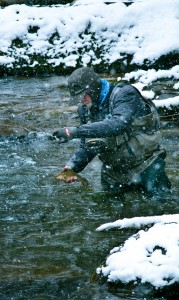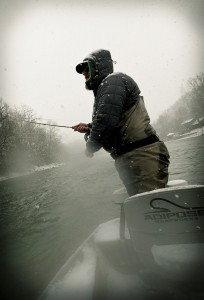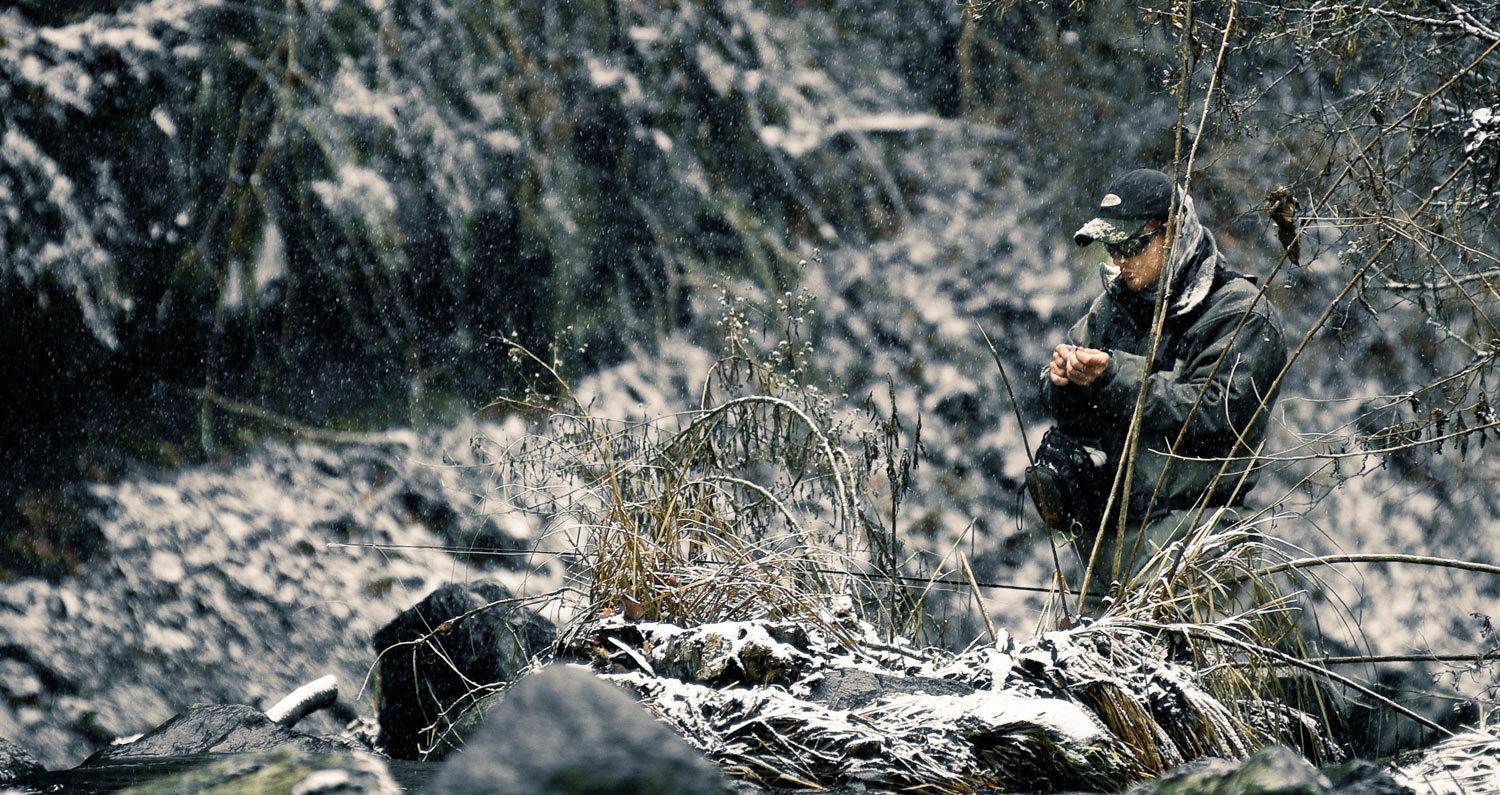By Kyle Wilkinson
Being prepared for a day of winter fishing means more than having a box of the right flies.
I got an email earlier today from a customer who had just gotten back from the river. He had attempted to fish the South Platte however, after several hours of trying to cast between floating icebergs and slush, he decided to wave the white flag and head home. His question was to know how to predict these sort of conditions ahead of time- before making the hour plus drive to find an unfishable river.
The South Platte, like virtually every other tailwater around the country, is well known to be a year-round fishery. With that said, there are still a few other factors that need to be considered when planning a winter outing. Following these 5 steps are just as important as your fly selection if having a comfortable and successful day on the water during winter is your goal.
Nighttime Temperatures. Everyone loves to pay attention to the daytime temps you’re likely (or more like keeping the fingers crossed) to experience during your day of winter fishing. A sunny, 40 degree day during January can feel like a heat wave, particularly if you’re coming off a nasty cold stretch leading up to it. And while pleasant daytime temps are something no one will complain about, the nighttime temperatures in the days leading up to your trip are just as important to pay attention to. Given the fact that it’s winter, fishing a tailwater is always going to be your best bet. If you see nighttime temps are hovering around freezing, plan on seeing the majority of the river open. On the other hand, if your day on the water is immediately following a especially cold stretch- i.e. single digits (or lower) at night, followed by sub 32 degree days, then plan on the situation mentioned in the first paragraph to be what you encounter. Thankfully, given the wonderful nature of tailwaters, the remedy to avoid fishing in a “Slushy” is to just plan on fishing closer to the dam. The water should remain warm enough–particularly within the first mile below the outlets– to remain relatively ice free compared to the lower stretches.
 Layer Properly. I know this seems like common sense, but it’s something I see a lot of people do wrong. First off, quit wearing jeans under your waders (even if you do wear some long johns underneath them). Jeans are extremely hard on the interior of your waders, particularly the rivets around the pockets. As a matter of fact, I was talking to an employee at Simms the other day and he said when a pair of waders comes in for repair, they can instantly tell if the person has been wearing jeans under them based off the damage to the internal shell. Additionally, jeans are made of cotton and there is no room for this on the water– particularly in the winter. Cotton does not breathe and if it becomes wet–through perspiration or an untimely step across a slick rock– is going to retain the moisture, thus making you even colder. The entirety of your layering system should consist of wool or synthetic materials, which will wick away any excess moisture, keeping you much warmer and more comfortable.
Layer Properly. I know this seems like common sense, but it’s something I see a lot of people do wrong. First off, quit wearing jeans under your waders (even if you do wear some long johns underneath them). Jeans are extremely hard on the interior of your waders, particularly the rivets around the pockets. As a matter of fact, I was talking to an employee at Simms the other day and he said when a pair of waders comes in for repair, they can instantly tell if the person has been wearing jeans under them based off the damage to the internal shell. Additionally, jeans are made of cotton and there is no room for this on the water– particularly in the winter. Cotton does not breathe and if it becomes wet–through perspiration or an untimely step across a slick rock– is going to retain the moisture, thus making you even colder. The entirety of your layering system should consist of wool or synthetic materials, which will wick away any excess moisture, keeping you much warmer and more comfortable.
Wear One Pair Of Socks. I’m sure a few of you reading this will disagree, but don’t wear more than one pair of socks. I know it makes sense on a surface level that if ‘one pair of socks is warm, two should be warmer’, but in reality the exact opposite is true and here’s why. The second pair of socks you put on over the first is going to compress the first pair tighter to your feet. This extra pressure is going to cut down on blood circulation to your feet, which will make them colder. With the research and technology that goes into clothing these days, there are plenty of fantastic options for socks out there made specifically for extremely cold conditions.
Grub It Up and Drink It Down. Many people I talk to claim they don’t eat when they’re fishing. The reasons for this are many and range from ‘forgetting to’ to not feeling hungry while fishing, to not wanting to waste a single moment on the water, etc, etc. When it’s cold outside your body is going to burn more calories in an attempt to stay warm– particularly when you start shivering. Making sure to bring along some high calorie snacks such as trail mix or granola bars will ensure your blood sugar levels don’t drop, making you weaker and colder. Additionally, drink lots of water. Staying hydrated is another easy way to ensure your body is functioning on all 8 cylinders. Side note: drinking alcohol should be avoided if you’re really worried about the cold. I know the nip of bourbon tastes damn good when you’re bundled up on the river, but the fact is alcohol dehydrates your body which is never going to be the best way to stay warm.
 Focus On The Core And Work Your Way Up. In my opinion, keeping the core warm is what it’s all about. My typical layering system for extremely cold days is a wool long underwear top, followed by a fleece quarter-zip pullover, followed by a puffy Primaloft or down vest, followed by an exterior Gore-Tex shell. I’ll also wear a buff (either synthetic or wool) as well. Even if it’s not pulled up on my face, the buff will help seal in heat around your neck that may be trying to escape. I think wearing the buff pulled up on your face– even if it’s not sunny– can help keep you warmer in the winter by preventing your skin from being as directly exposed to the cold and wind. Lastly, I always top my layering off with a good stocking cap to keep heat from escaping through my head.
Focus On The Core And Work Your Way Up. In my opinion, keeping the core warm is what it’s all about. My typical layering system for extremely cold days is a wool long underwear top, followed by a fleece quarter-zip pullover, followed by a puffy Primaloft or down vest, followed by an exterior Gore-Tex shell. I’ll also wear a buff (either synthetic or wool) as well. Even if it’s not pulled up on my face, the buff will help seal in heat around your neck that may be trying to escape. I think wearing the buff pulled up on your face– even if it’s not sunny– can help keep you warmer in the winter by preventing your skin from being as directly exposed to the cold and wind. Lastly, I always top my layering off with a good stocking cap to keep heat from escaping through my head.
When it comes to winter fishing, taking these few extra steps can go a long way in ensuring your mind is able to stay focused on the fish…..and not just on how damn cold you are!
Kyle Wilkinson Gink & Gasoline www.ginkandgasoline.com hookups@ginkandgasoline.com Sign Up For Our Weekly Newsletter!

